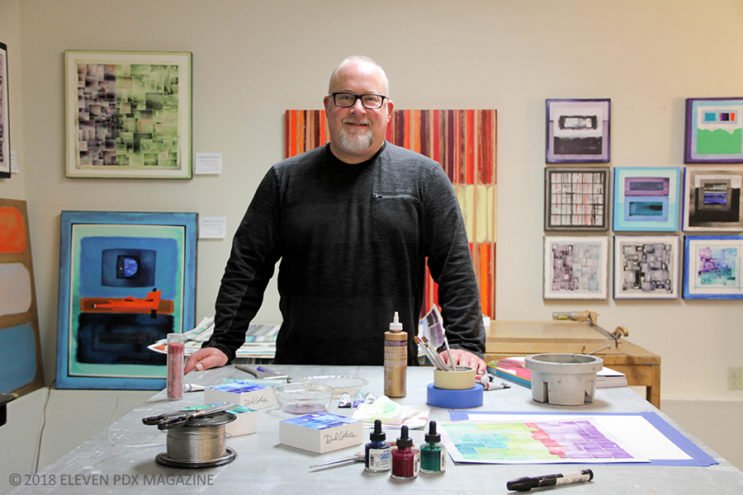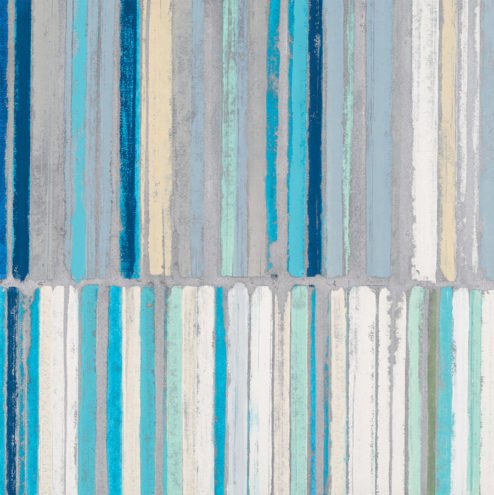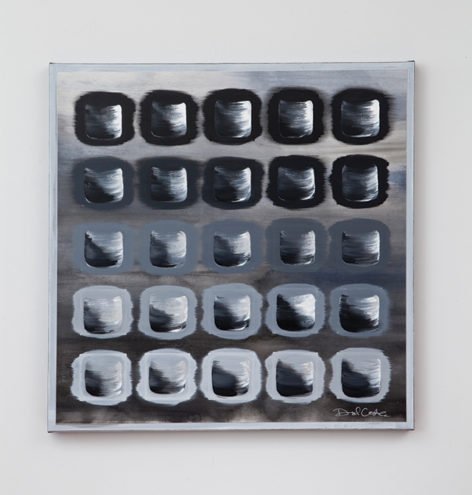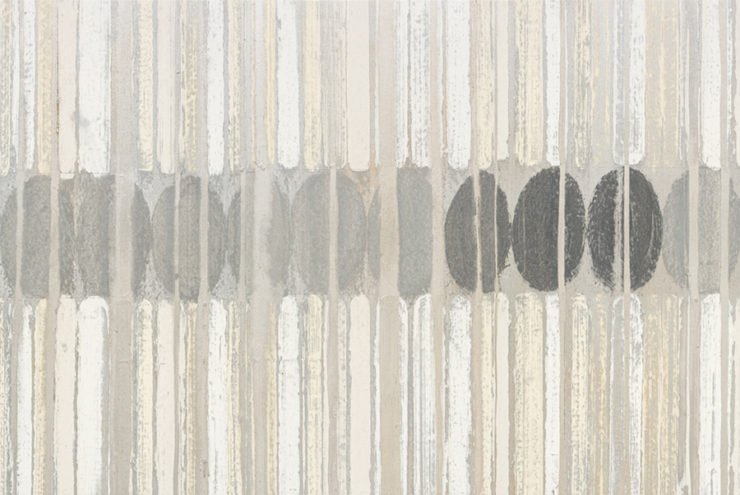Portland Artist David Castle


ELEVEN: All of your pieces seem to have a natural element to them. What is it about nature that captures your attention, over portraits or other subjects?
David Castle: I’m a rather introverted, quiet guy and shy away from the “man-made,” whether noise and chaos or clunky structures. Nature offers a quiet retreat from all that is man-made and I’ve always embraced it. For much of my childhood I grew up on a farm, where nature became my natural habitat and I learned to love all it has to offer–especially the woods and forests of my native Colorado. My favorite colors are also found in the cool spectrum of nature–greens, purples and blues–so I’m naturally drawn to what God’s earth has to offer. Finally, I’m drawn to striking vertical and horizontals on the scale that nature does the best–towering trees, and the horizon line between sea and sky that stretches as far as I can see.

11: You’ve said that your paintings arise from your dreams. Can you explain that process from dreamscape to canvas?
DC: This is a pretty literal process for me, whether from a daydream or sleep dream. The content of sleep dreams is typically hard for me to remember except those where I dream of a completed painting. Since I rarely sleep dream about the process of creating that finished piece, I’ll remember vivid sections of the completed paintings from my dream. I can then recall these completed sections in my studio and make into the beginnings of an actual painting.
Daydreams tend to work a bit harder for me–I usually can envision my painting process, daydreaming the making of a part or whole painting. Interestingly, I never see myself in any of these dreams–my dream canvas paints itself with no apparent artist tools. Either way, all of these dreams give me a starting point, and often an ending to what I’ll paint when I get to work in my studio.

11: What has your background in computer science brought to your life as an artist? Did you find the transition from such a left-brained career to something so right-brained to be challenging?
DC: My former IT career has heavily influenced the business side and logistics of being an artist (planning, budgeting, operations). Creatively, I know that the structure and geometrical aspects of “old fashioned” computer programming have shown up in my art. Nothing used to satisfy me more than programming a piece of structured software, with neat, nested lines of code and boxes. Equally satisfying is painting one of my “Pacific Rains” series with neat-but-organic vertical lines and geometry. Or, painting one of my abstract watercolors from my “Elementals” series, which are fields of squares and rectangles.
I believe I’ve always been a “right-brained” guy, even though I took such a technical path in college and with my first career. Transitioning to my artist career felt like an abrupt, but easy, shift into gears that I was always meant to be cruising in.
11: When did your artistic career begin and how did it come about? Have you always been artistic or considered yourself an artist?
DC: I was a rather artistic child–some art and lots of music is in my background. My “real” introduction to making art, and specifically watercolor painting, came when I lived in Belgium as a computer consultant. An artist in my apartment building held weekend art classes, and although I spoke little French and she spoke little English, I took a class in watercolor and we just painted–little abstracts and landscapes.
As an adult, after 15 years in a technology career, I knew that technology wasn’t going to be my “forever” passion. I had moved from hands-on work developing software to project management, which put me further away from the details of technology that had interested me most in the first place. So, I knew I needed to plan a career change someday. When my last IT job was eliminated rather abruptly, I decided to make my career change happen at that moment rather than a future moment that may never arrive. I began to explore both landscape design and my art in search of a new career. With some immediate, positive feedback from family and friends on small watercolor abstracts I was painting, I began exhibiting in local and regional art festivals. More positive feedback from festival crowds (and encouraging sales) helped make my new career stick. I also was fueled by my new-found need to not go back to the corporate world, and struck out on my own artistic path. I’ve taken many classes and workshops from national and international artists over the years to help develop my skills and own style.

11: You have dedicated several series to the Pacific Northwest, choosing to focus on several elements we are known for–rain and trees. There is a vertical/linear aspect to both of those elements that you have captured in your work. What about that linear aspect intrigues you?
DC: What is more perfect than a line? Or four lines made into a square (my most favorite shape)? My love of nature has shown me some of the best examples of linear components. Trees are a great example of both the vertical and linear aspects that I’m drawn to. And trees often inspire the vertical shapes in my abstracts, and sometimes even appear as recognizable components–such as tree trunks–in my more representational abstracts.
Interestingly, one component of nature that I find most compelling is the horizon line between sea and sky–about as horizontal as you can get in nature. Sometimes a horizon line appears in my more landscape-themed abstracts, but most of my paintings really have a vertical energy to them. The vertical comes from my favorite painting process and a very satisfying vertical gesture motion that I use when I paint, particularly with oils. There is more for me to discover with the horizontal influence of nature’s horizon line and I’ve more work to do to unearth that.
11: Congratulations on your recent acceptance into the 2018 Autumn Arctic Circle Residency Expedition! What are you most looking forward to in your growth as an artist on this expedition to the Arctic Circle? Do you have a specific project in mind for your time there? Is it a time for creation as well as reflection or do your art supplies stay here in Portland?
DC: Thanks! I’m super excited for this unique opportunity and will begin gearing up in early January. The Expedition is on a Barkentine tall ship and I’ll be sailing around the arctic with nearly 20 other artists and scientists from around the world for three weeks! The departure point is from an old mining town–Longyearbyen, Svalbard (Finland). Hundreds of artists from across the world apply for only a few openings each year, so I’m thrilled that the selection committee chose me! It’s a small ship with limited space, so I’m not yet sure what materials I’ll bring. I’ll have minimal space for making art, so I’ll hone in on the necessities.
While I have ideas for how I’ll use this journey and time artistically, I’ll tackle many of the logistical components of the trip early in the process. First, I must raise funds to pay for a portion of the Expedition, travel to Finland and gear for subzero temperatures–upwards of $10,000. I’ll be doing a Kickstarter campaign with different levels of pledges offering contributors a range of benefits from receiving a postcard from me mailed from the most northerly post office on the planet (Longyearbyen), to receiving an original painting that I will paint while on the Expedition in the Arctic Circle.
Artistically, I’ll use the Expedition as an opportunity to explore my continued fascination with water and ocean landscapes. But in this case, I’ll be looking for how I’m inspired and affected by a mostly frozen water landscape and horizon line of ice and snow. I can’t wait to see what I’ll paint after putting my eyes and hands on an arctic iceberg!

11: Where can we see some of your pieces locally, either on display or for sale?
DC: In Oregon, I’m represented by RiverSea Gallery in Astoria, right on Commercial Street in downtown Astoria. At RiverSea, you’ll see several of my “Pacific Rains” and “Oregon Birch” paintings in a variety of sizes and price points. In Portland, I have an exhibit of “Pacific Rains” paintings hanging in the Mezzanine at Bridgeport Brewery in the Pearl through the end of February. Coming up in January, I’ll have several larger-format paintings on exhibit at Bridgeport Family Medicine in Tigard. Finally, my studio in Portland’s Garden Home neighborhood is always open by appointment for folks to check out my creative space and see my most recent paintings, call or email me anytime to schedule a visit!
Find this artist online:
Facebook: facebook.com/davidcastleart
instagram: @davidcastleart



